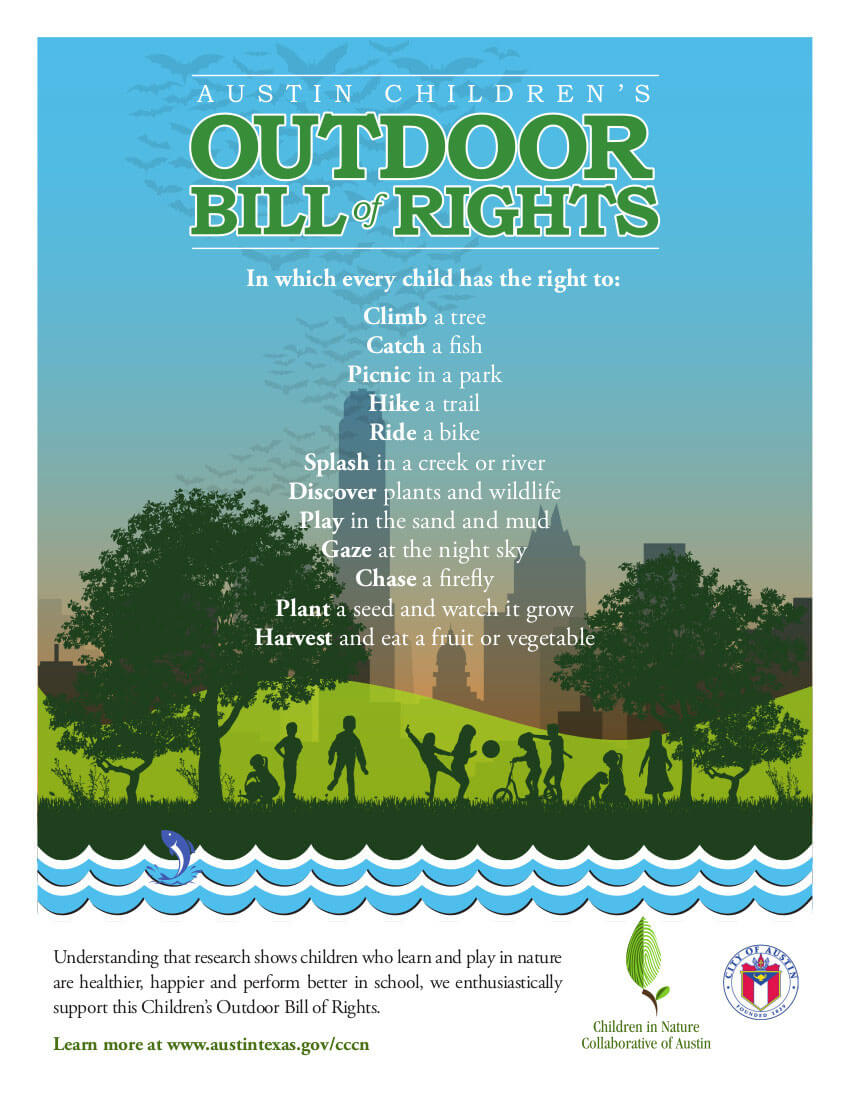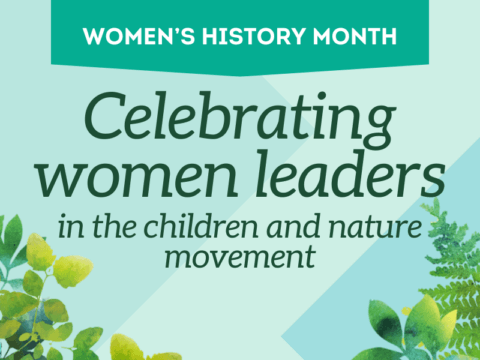Children’s Outdoor Bill of Rights bring leaders, residents together
On a cold mid-January evening in Rochester, NY, a group of young people stand around a circle in a snow-covered forest cheering for each other. Their aim? Start a fire with only one match.
“When the fire finally went off, everyone felt so empowered. It was invigorating,” said Stephanie Benway, Environmental Education Specialist for the City of Rochester’s Department of Recreation and Youth Services. Since these teens will lead the process for Rochester’s Children’s Outdoor Bill of Rights (COBOR), team building and connecting to nature were the activity’s goal. And they achieved it.
Through the COBOR process, the City of Rochester wants to engage youth and the local community while also identifying local partners that share a common interest in connecting kids to nature. “With COBOR, it’s not so much about the end product,” Benway said. “It’s about spreading awareness through the process and the conversations.”
Many leaders who have developed childrens’ outdoor bills of rights agree. “It’s more about galvanizing residents and partners to bring about the programs, policies, funding or activities needed to help children develop a relationship with nature,” said Monica Lopez Magee, Director of Cities and Community Engagement for the Children & Nature Network and co-lead for the Cities Connecting Children to Nature (CCCN) initiative, a national partnership between the National League of Cities and the Children & Nature Network.
“They [city leaders] see it as a public-facing symbol, a messaging tool, and an opportunity to raise awareness for the importance of giving all children equitable access to nature’s benefits,” said Lopez Magee.
A childrens’ outdoor bill of rights is usually a list of specific outdoor experiences that every child deserves. It can be passed as a resolution, proclamation, or program. Fifteen states and six cities have COBORs in place or in development.
Surveys and open forums are ways cities gather input from residents and partners to decide which nature-based experiences to prioritize. San Francisco executed a paper and online survey to help narrow down the 100 rights originally drafted. The survey, translated in Spanish and Chinese, helped San Francisco’s COBOR process gain visibility and identify local partners. Some elementary schools even used the survey data in math lessons.

San Francisco’s original COBOR poster.
Seattle, WA is going through a COBOR process now and recently conducted a city-wide survey. With 96% of respondents saying they’d likely sign on to the COBOR, the results gave Seattle renewed energy for its efforts.
Seattle continues to use their survey results to engage local partners. Amidst COVID-19, Seattle City Parks and Recreation staff brought together local nonprofits, educators, and staff from other city departments for a virtual COBOR conversation. The convening had two main objectives: 1) learn from other cities; they featured representatives from Salt Lake City and San Francisco who have established COBORs and 2) listen to local stakeholders; attendees broke out into small virtual groups to discuss the outdoor experiences that all children in Seattle deserve to have.
In Salt Lake City, Utah (SLC) a group of kids gather around their camp leader eager to get their “catch a bug” sticker—one of 13 stickers they can earn after completing outdoor activities listed as part of the city’s COBOR program.
SLC is an example of how the process helped identify partnerships and tangible outcomes. The initial idea was to use their COBOR as a springboard to connect with partners that could provide activities for children, said Lewis Kogan, Director of Divisions of Trails & Natural Lands for SLC. But, through the process, the city pivoted its plans in early 2019.
SCL transitioned its COBOR into an on-the-ground program that offers 13 nature experience rights into outdoor activities. The SLC Youth and Families department offers summer programs and free family activities to encourage children and their families to try each activity. By offering easy and supportive ways for children to catch a bug, follow a foothill trail, observe a starry sky, explore a cave or paddle a boat, the city hopes to encourage consistent nature connections.
In fact, SLC’s COBOR process helped spur a statewide COBOR. The Utah Department of Recreation loved what SLC was doing so much that within six months, the Utah legislature created a state-wide COBOR. “The state created their own COBOR initiative, which has a healthy bit of funding behind it,” said Kogan. “We are really excited to have been the catalyst for that process.”
That catalytic process is exactly what Lopez Magee hopes will happen as more cities look for ways to encourage children and nature connections. “A COBOR is so much more than a piece of paper. It can really be a spark for cities as they see the potential it has to align with and support other city priorities,” Lopez Magee said.
To help cities start or advance COBORs for their communities, the Cities Connecting Children to Nature (CCCN) initiative offers a list of lessons learned:
- Include more co-signers for greater impact. “For example, a city government-led COBOR can be more impactful if they include the school district, county health department, federal land agencies and grassroots partners,” Lopez-Magee said.
- Use the COBOR as a media opportunity to tie in other related goals or activities. In Baltimore, Mayor Young signed Baltimore’s COBOR at an event celebrating Baltimore Wildlife Week, serving as a media opportunity while accomplishing another city goal.
- Create a “one-two punch” launching COBOR with another nature connection project. In Austin, TX, the COBOR was a collaboration between various city agencies and the local school district; it was launched alongside a green schoolyards project to prove that the partners were serious about making nature connections a reality.
- Connect COBOR rights with existing children’s programming and in partnership with agencies that have trusted relationships with children and families. Salt Lake City engaged a trusted city agency that already had connections to local kids and their families. This partnership allowed the city to create a tangible program with funding attached.
- Develop the COBOR with an eye towards equity. San Francisco and Austin use equity zone mapping to determine where children are lacking access to their outdoor rights and need further resources and programs.
“A COBOR can be unique for every city in that it can reflect the needs, priorities and assets of that city,” said Lopez Magee. “And yet, there are things that all children across the country should have a right to, such as access to clean air, feeling safe and welcome in nature, or access to local green spaces. Developing a COBOR helps city residents and partners understand the importance of giving all children those opportunities. That mind shift alone is priceless.”

Austin, Texas’ COBOR poster.
The National League of Cities (NLC) is a critical contributor to COBOR development through Cities Connecting Children to Nature (CCCN), a joint initiative with the Children & Nature Network. Vera Feeny, Senior Program Specialist in Children & Nature for NLC’s Institute for Youth, Education and Families, provided source material and expertise for this article.
2 Comments
Submit a Comment
Cities Connecting Children to Nature (CCCN) Resource
Children’s Outdoor Bill of Rights (COBOR) Strategy Tool
-
Network News
Earth Day: Young leaders advocate for change
-
Feature
Nature photographer Dudley Edmondson has a vision for the representation of Black and Brown faces in the outdoors
-
Richard Louv
EARTH MONTH: You're part of the New Nature Movement if....
-
Voices
Placemaking: How to build kinship and inclusive park spaces for children with disabilities
-
Network News
Children & Nature Network founders release report on global factors influencing the children and nature movement







I love the COBOR idea and was wondering where could I learn more information to possibly get one going for the city of San Antonio?
Thank you
Hi Josie,
Wonderful to hear of your interest in a COBOR for San Antonio. This CCCN COBOR resources provides more details on the process as well as examples of existing COBORS: https://www.childrenandnature.org/wp-content/uploads/CCCN_COBOR_whatis_21-1-20_final.pdf. Let’s connect with Kelsey and SA PARD and the SA Children in Nature Collaborative to build momentum. Please feel free to reach out to me directly for us to connect with others in San Antonio to initiate the process. You can reach me at monica(at)childrenandnature.org.
Best,
Monica